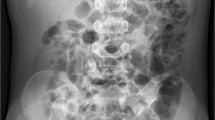Abstract
The objectives of the study were (1) to determine the interobserver variation in interpretation of abdominal radiographs in children with clinically suspected intussusception, and (2) to determine the diagnostic value of abdominal radiographs in these patients. One hundred and eighty-two plain abdominal radiographic examinations (AXR) performed in children with clinically suspected intussusception were reviewed blind to the clinical history and findings of air enema. The presence or absence of nine AXR signs relevant to intussusception was documented. Each AXR was categorized as equivocal, positive or negative for intussusception, with the aim of achieving no false negatives. Interobserver variation in the identification of AXR signs and radiologic diagnoses was calculated using the kappa statistic for 60 cases assessed independently by three observers. Using the findings of air enema as gold standard, the prevalence of AXR signs in all patients with (60) and without (122) intussusception was determined and their diagnostic values calculated. The best observer agreement was for the presence of sparse small bowel gas (supine,k=0.68) and the worst for the presence of cecal gas (erectt,k=0.18). All three observers agreed intussusception to be present or absent in only 7 of 60 cases and the majority agreement was equivocal in more than half. Overall agreement between observers for the diagnosis of intussusception wask=0.30. The best positive predictors of intussusception were the soft tissue mass and sparse large bowel gas, with likelihood ratios of 3.9 and 2.5. Cecal feces predicted against intussusception, likelihood ratio 0.11. AXR was equivocal in 53%, positive in 21% and negative in 26%. Where a firm radiographic diagnosis was made, the diagnostic accuracy of AXR was 84%. When equivocals were included, diagnostic accuracy of AXR was only 40%. Two of 43 AXR-negative patients had intussusception at air enema. Interobserver agreement in the interpretation of abdominal radiographs in suspected intussusception is limited. AXR are equivocal in more than half the cases, and there is no significant diagnostic benefit of the erect examination.
Similar content being viewed by others
References
Pracros JP, Tran-Minh VA, Morin de Finfe CH, Defferenne-Pravos P, Louis D, Basset T (1987) Acute intestinal intussusception in children. Contribution of ultrasonography (145 cases). Ann Radiol 30:525–530
Verschelden P, Filiatrault D, Garel L, Grignon A, Perreault G, Boisvert J, Dubois J (1992) Intussusception in children: reliability of US in diagnosis — a prospective study. Radiology 184: 741–744
Bolin H (1964) Conventional roentgenography in diagnosis of intussusception in children. Acta Radiol Diagn 2:32–40
LeVine M, Schwartz S, Katz I, Burke H, Rabinowitz J (1964) Plain film findings in intussusception. Br J Radiol 37:678–681
Eklof O, Hartelius H (1980) Reliability of the abdominal plain film diagnosis in pediatric patients with suspected intussusception. Pediatr Radiol 9:199–206
White SJ, Blane CE (1982) Intussusception: additional observations on the plain radiograph. AJR 139:511–513
Fleiss JL (1973) Statistical methods for rates and proportions. Wiley, New York
Markus JB, Somers S, Franic SE, Moola C, Stevenson GW (1989) Interobserver variation in the interpretation of abdominal radiographs. Radiology 171:69–71
Ratcliffe JF, Fong S, Cheong I, O'Connell P (1992) The plain abdominal film in intussusception: the accuracy and incidence of radiographic signs. Pediatr Radiol 22:110–111
Eklof O, Thonell S (1984) Conventional abdominal radiography as a means to rule out ileocaecal intussusception. Acta Radiol Diagn 25:265–267
Johnson JF, Woisard KK (1989) Ileocolic intussusption: new sign on the supine cross-table radiograph. Radiology 171: 483–486
Humphry A, Ein SH, Mok PM (1989) Perforation of the intussuscepted colon. AJR 137:1135–1138
Todani T, Sato Y, Watanabe Y, Toki A, Uemura S, Urushihara N (1990) Air reduction for intussusception in infancy and childhood: ultrasonographic diagnosis and management without x-ray exposure. Z Kinderchir 45:222–226
Bhisitkul DM, Listernick R, Shkolnik A, Donaldson JS, Henricks BD, Feinstein KA, Fernbach SK (1992) Clinical application of ultrasonotraphy in the diagnosis of intussusception. J Pediatr 121:182–186
Author information
Authors and Affiliations
Additional information
Presented in part to a meeting of the European Society of Pediatric Radiology, June 1993, London UK
Rights and permissions
About this article
Cite this article
Sargent, M.A., Babyn, P. & Alton, D.J. Plain abdominal radiogrophy in suspected intussusception: A reassessment. Pediatr Radiol 24, 17–20 (1994). https://doi.org/10.1007/BF02017652
Received:
Accepted:
Issue Date:
DOI: https://doi.org/10.1007/BF02017652




